Explore Angkor Wat Temple , Bayon Temple and Jungle Temple Ta-Prohm
As the morning sun gently illuminates the intricate stone carvings of Angkor Wat Temple, one can’t help but feel transported back in time to an era of splendor and mystique.
The allure of Bayon Temple’s enigmatic smiling faces and the untamed beauty of the Jungle Temple Ta-Prohm beckon adventurers seeking a glimpse into Cambodia’s ancient past.
But what secrets lie hidden within these hallowed walls, waiting to be uncovered by those willing to venture forth?
Key Points
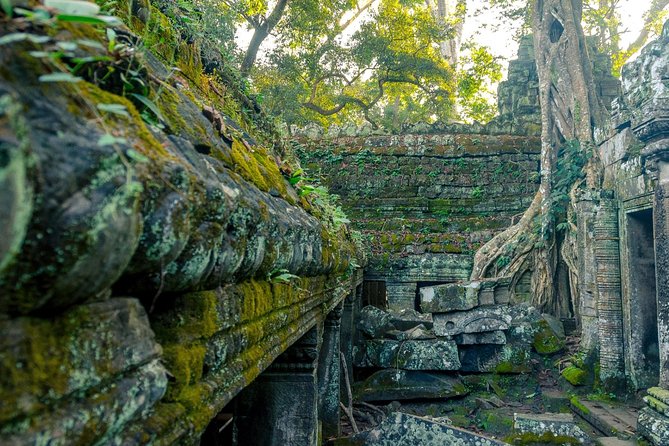
- Angkor Wat: Largest religious monument with intricate carvings and Hindu symbolism.
- Bayon Temple: Iconic smiling stone faces and transition from Hinduism to Buddhism.
- Jungle Temple Ta-Prohm: Blend of architecture and nature, recognizable film location.
- Conservation Efforts: Ongoing restoration and preservation initiatives to maintain the historical and natural beauty.
Angkor Wat Temple Overview
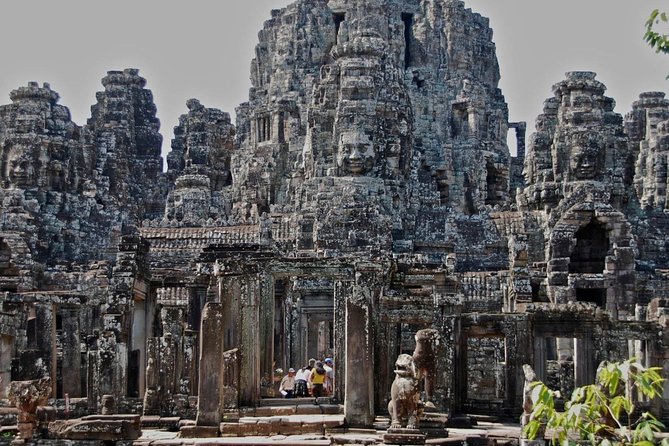
Nestled amidst the lush landscapes of Siem Reap, Angkor Wat Temple stands as a majestic symbol of Cambodia’s rich history and architectural brilliance. As the largest religious monument globally, Angkor Wat showcases intricate temple architecture that blends Khmer design with Hindu symbolism.
The temple’s five towers symbolize Mount Meru, the home of the Hindu gods, while the outer walls depict epic scenes from Hindu mythology and historical battles. The central sanctuary houses a massive statue of Vishnu, a significant deity in Hinduism.
Visitors are captivated by the temple’s grandeur and attention to detail, from the intricate bas-reliefs to the towering spires that dominate the skyline. Angkor Wat’s architectural grandeur and historical significance make it a must-visit destination for travelers seeking to enjoy Cambodia’s ancient heritage.
History of Angkor Wat Temple
The historical origins of Angkor Wat Temple trace back to the early 12th century, marking a pivotal era in Cambodia’s architectural and religious heritage. Built by King Suryavarman II, Angkor Wat is renowned for its unique blend of Khmer architecture and Hindu symbolism.
As the largest religious monument in the world, it stands as a testament to the grandeur and sophistication of the Khmer Empire. The temple’s layout, with its five towers representing Mount Meru, the abode of the gods, showcases the architectural significance of Angkor Wat.
Intricate carvings depicting mythological stories and historical events adorn its walls, offering a glimpse into the rich cultural tapestry of the time. Angkor Wat’s temple origins and architectural mastery continue to awe visitors from around the globe.
Bayon Temple Highlights
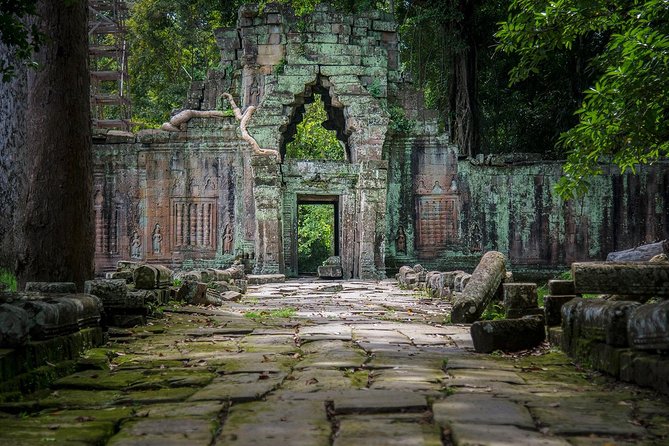
Amidst the ancient ruins of Angkor Archaeological Park, Bayon Temple captivates visitors with its iconic smiling stone faces and intricate bas-reliefs depicting historical and mythological narratives.
The Bayon temple sculptures are a highlight, showcasing over 200 massive faces believed to be a combination of bodhisattva Avalokiteshvara and King Jayavarman VII. These enigmatic faces exude a sense of serenity and wisdom, leaving travelers in awe of their craftsmanship and scale.
Plus, the temple’s bas-reliefs depict various scenes from everyday life, battles, and religious ceremonies, offering a glimpse into the past of the Khmer Empire.
As visitors explore the temple grounds, they may also encounter some jungle temple wildlife, such as monkeys and exotic birds, adding a touch of adventure to the historical experience.
Bayon Temple Architecture
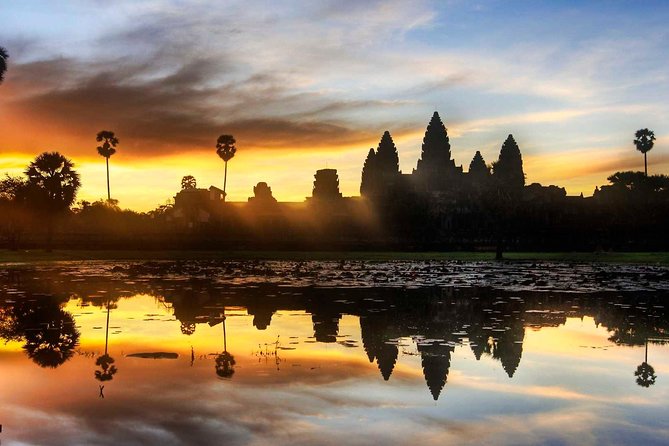
Visitors to Bayon Temple are immediately struck by the intricate architectural design that seamlessly blends religious symbolism with artistic mastery. The temple’s unique features include:
- Bayon Temple Sculptures: Intricately carved stone reliefs depicting various scenes from daily life, battles, and religious ceremonies.
- Angkor Architecture Evolution: Demonstrates the transition from Hinduism to Buddhism in the region through architectural elements like multiple towers and serene smiling faces.
These elements showcase the rich history and cultural significance of Bayon Temple, making it a must-visit for those interested in exploring the evolution of Angkor architecture.
Discovering Ta-Prohm Temple
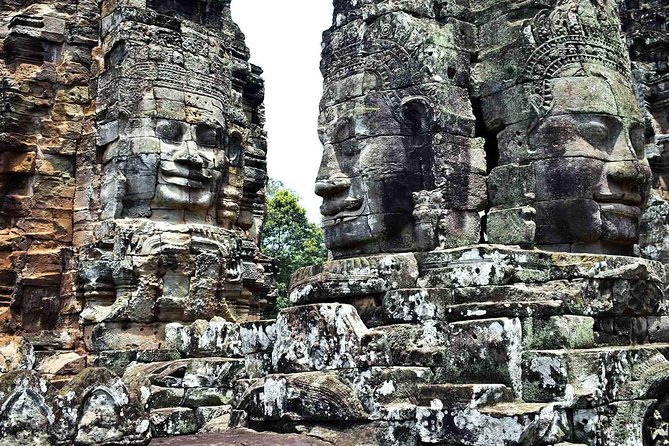
Nestled within the lush jungle of Cambodia lies Ta-Prohm Temple, a captivating ancient site where nature and history intertwine in a mesmerizing display of beauty and mystery. The temple is famous for its unique blend of stunning architecture and the encroaching embrace of towering trees and snaking roots, creating an awe-inspiring sight.
While exploring Ta Prohm, visitors can witness ongoing restoration efforts to preserve the temple’s fragile structures and prevent further decay. Beyond its popular attractions, Ta Prohm also hides lesser-known gems waiting to be discovered by intrepid explorers. These hidden gems offer a more secluded and intimate experience, allowing visitors to connect with the temple’s ancient past in a peaceful setting away from the crowds.
Ta-Prohm Temple Features
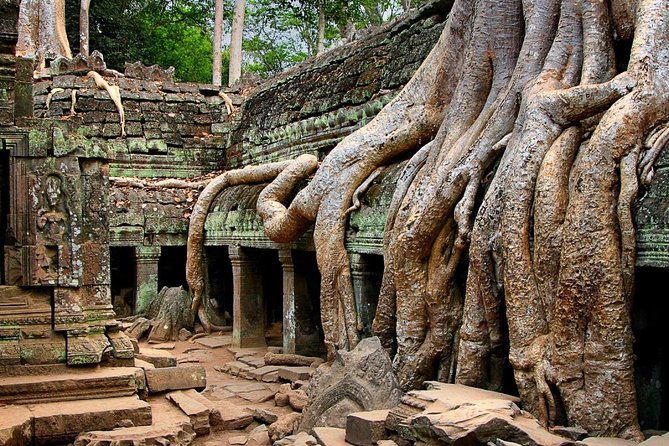
Ta-Prohm Temple boasts a captivating blend of ancient stone structures intertwined with the intricate embrace of nature, showcasing a unique and mesmerizing architectural harmony.
- Conservation Efforts: Ongoing efforts to preserve the temple’s delicate balance between stone and tree roots.
- Unique Architecture: Distinctive features include tree roots growing over and around the temple walls.
- Mysterious Atmosphere: The temple’s untouched state creates an enchanting and slightly eerie ambiance.
- Popular Film Location: Recognizable from its appearance in famous movies, adding to its allure.
Visitors are drawn to Ta-Prohm not only for its historical significance but also for its striking appearance, making it a must-see destination for those exploring the temples of Angkor.
Jungle Temple Exploration

Set out on a captivating journey through the lush jungle to uncover the hidden marvels of ancient temples waiting to be explored.
The Jungle Temple, also known as Ta Prohm, offers a unique blend of history and nature, with tree roots intertwining with the temple’s structures, creating a mystical atmosphere.
Visitors can capture stunning jungle temple photography, showcasing the intricate details of the temple being slowly reclaimed by the surrounding forest. Conservation efforts are in place to preserve this harmonious fusion of man-made architecture and natural beauty.
As you traverse through the overgrown paths and moss-covered stones, you’ll be immersed in the captivating allure of Ta Prohm’s untouched wilderness, making it a must-visit destination for any explorer seeking a glimpse into Cambodia’s rich history and jungle landscapes.
Ta-Prohm Temple Conservation
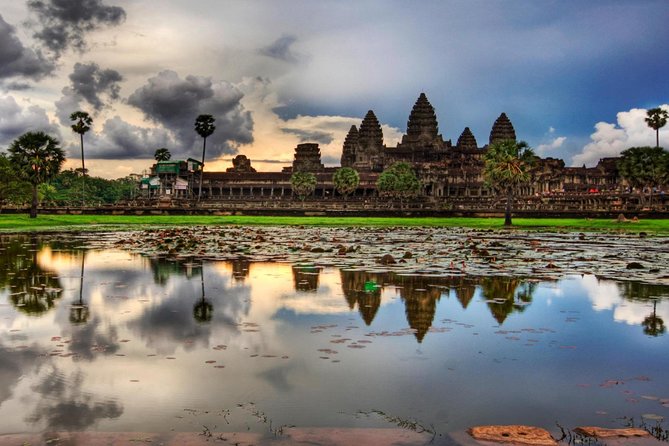
Conservation efforts at the Ta-Prohm Temple aim to protect and preserve the unique blend of ancient architecture and natural elements intertwined within its structure.
-
Ongoing restoration work focuses on maintaining the temple’s structural integrity.
-
Environmental impact assessments guide conservation practices to ensure sustainability.
-
Collaboration with local communities enhances conservation efforts and promotes awareness.
-
Balancing tourism with preservation is a key challenge faced by conservationists at Ta-Prohm.
Common questions
How Far in Advance Should I Book the Tour to Explore Angkor Wat Temple, Bayon Temple, and Ta-Prohm Temple?
To ensure availability during peak season, it is advisable to book the tour to explore Angkor Wat Temple, Bayon Temple, and Ta-Prohm temple at least a few weeks in advance. The tour duration typically spans a full day.
Are There Any Restrictions on Photography at the Temples?
Photography rules at the temples aim to preserve their cultural integrity. Visitors should respect guidelines to protect these historical sites. It’s crucial to balance capturing memories with ensuring the preservation of these ancient wonders for future generations to appreciate.
Can I Climb to the Top of the Temples for a Better View?
Visitors must adhere to safety precautions and temple etiquette. Climbing regulations vary; some temples restrict access to certain areas. Check with guides for permitted viewpoints. Respect the historical sites by following rules for a memorable experience.
Are There Restroom Facilities Available at the Temple Sites?
Restroom facilities are available at the temple sites. Travelers can conveniently use these facilities during the tour. Booking this tour includes access to these amenities. It ensures a comfortable and smooth experience for visitors.
Is There a Dress Code or Specific Attire Required for Visiting the Temples?
When visiting the temples, there is a dress code for cultural sensitivity. Visitors are advised to wear modest clothing that covers shoulders and knees. It is a sign of respect for the sacred sites.
Last Words
Set out on a mesmerizing journey through Cambodia’s ancient wonders with a tour of Angkor Wat Temple, Bayon Temple, and the Jungle Temple Ta-Prohm. Enjoy the rich history and architectural marvels of these iconic sites, guided by knowledgeable English tour guides.
With all entrance fees, meals, and amenities included, this adventure promises an unforgettable experience.
Explore the heart of Cambodia’s heritage and uncover the mysteries of these awe-inspiring temples, each a testament to a bygone era of grandeur.